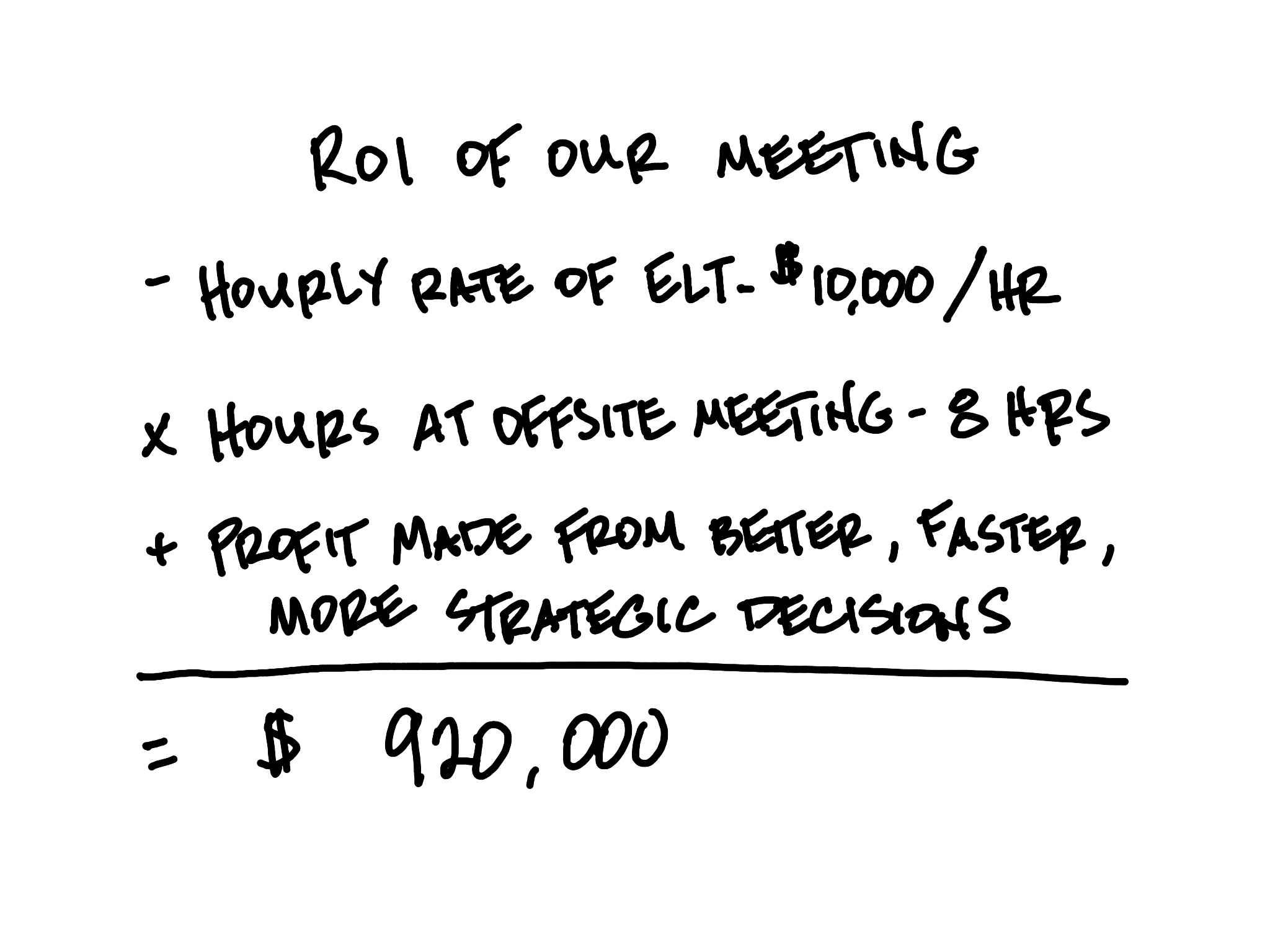True story: At an offsite with a large corporation, I watched the team completely waste an hour in meaningless, unproductive conversation. I called for a break and asked the CFO a fairly pointed question, “How much did that hour cost us?” She looked at me confused. Then I asked, “Could you please estimate the hourly wage of everyone in this room?” Awkward silence. But, she did it. She quickly took out a sheet of paper and roughed out the math. “It costs us about $6,000/hour every time we are all in the room.” Wow! “So, why don’t we make sure that we use this time for the highest and best use of this company?!” They all resonated with that and the energy in the room shifted. For the rest of the day we knocked out solutions and decisions that had broad-sweeping impacts for months and even years to come. Here’s how to protect your team’s time and get the most out of it.
Commit to Quarterly Offsites
Our clients who experience long-term results have a ruthless commitment to quarterly offsites as a leadership team. The agenda is not always clear, the planning is not always perfect, the timing is never ideal, but they do it. They recognize they cannot afford to miss it. Taking four times a year to not work in the business, but work on the business, is imperative.
There’s lots of ways to approach the agenda for these offsites. We’ve found it helpful to use the 4 Disciplines as a guide.
- Discipline 1: Do some work to build up your Cohesive Leadership Team (ex. review personality profiles).
- Discipline 2: Review and refine your Clarity (ex. establish a new Thematic Goal).
- Discipline 3: Determine how to Over-Communicate strategies internally and externally (what needs to be cascaded through the organization).
- Discipline 4: And work on healthy systems that can Reinforce the culture you are striving to build (ex. refine your hiring practices).
One of my best clients has a very simple discipline. Before one offsite is over, they put the next offsite on the books. Everyone pulls out their calendar and confirms the dates and times. Thirteen weeks is plenty of time for everyone to protect that space even from the most pressing priorities (ex. a new deal with a prospect).
Review and Refine Clarity
Much of a team’s Clarity does not change over time. This is true especially for questions like, “Why do we exist” and “How do we behave”, but other clarity questions are a bit more dynamic. For example, the question “what’s most important right now” has a 3-12 month runway. So, that means this question needs to be re-answered at least every year. Our question “who does what” deals with all the nuances of roles and responsibilities. We find this to be critical for teams and organizations to constantly watch over.
I have a client who simply begins every single offsite by going back over their Clarity. It’s only 6 questions, but as they go through that simple process, they find themselves slowing the conversation down to cover critical topics. They might hit the “what do we do” question and someone chimes in, “I know we develop software, but it feels like we are creeping away from our sweet spot as we try to win these new deals.” They might hit the “how do we succeed” question and have a vigorous debate about an opportunity for a new partnership that looks great but might be too good to be true.
Getting clarity is not a one-time exercise. Clarity is a tool for the highest level strategy. Our best clients use this tool, and the result is constantly better, faster decisions, with long-term results.
Cascading Communication
I had a client who recently said, “Our staff says they’re always curious to know what’s happening behind the curtain at Oz.” This was a friendly jab to remind the leadership team that they might be lacking in their cascading communications.
Our best teams use a simple exercise after offsites. They confirm they need to communicate and take those messages in person to their teams. To show the cohesiveness of their leadership team (a.k.a. Team 1), often multiple team members will attend. When the CFO brings news about the budget cuts to his team they might get some pushback about what I.T. is spending. But when the CFO and the CIO attend together and answer hard questions it minimizes the silos and creates more buy-in. Sounds like a time drain? Imagine the time drain from constantly re-visiting the budget cuts over the coming days and weeks when we miss the power of over-communicating!
Build Healthy Human Systems
As a leadership team thinks about reinforcing clarity, it’s certainly understandable that they will task their HR or People departments with some significant work. However, they cannot fall into the ‘delegation’ trap and absolve themselves of the responsibility. This can be painfully true when we consider your system of hiring and firing. We say “healthy organizations hire slow and fire fast.” It is leadership’s job to ensure that every person who walks through the door is a representation of their core values.
One of my clients made a change recently that helped them tremendously. Previously they were telling candidates about their core values and asking them for feedback. Well, of course, the interviewees were nodding their heads and agreeing with the values. Why would we expect any different from someone who is looking for a job? And, unfortunately, they ended up with some new employees who had short-lived tenure and cost the company thousands of dollars in turnover costs (and other collateral damage). So they decided to change the game a bit.
Now, instead of asking the candidates explicit questions about the company’s values, they put them into situations that test the values. For example, if they value a work ethic that is “willing to sweep floors” they might ask candidates to tell recent stories of times when they had to abandon their primary tasks to do grunt work. If their value is “intellectual curiosity” they may ask the candidate about things outside their expertise and see if they engage in a conversation or simply revert back to only what they know. You can’t make a person humble, but if humility is a core value, you can do some creative things to find humble employees who will share that value.





0 Comments